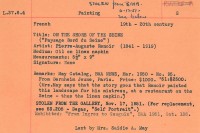 A court has ruled that the Renoir landscape that went on sale for $100,000 last year after its owner claimed to have bought it for $7 at a West Virginia flea market belongs to the Baltimore Museum of Art from which it was stolen in 1951. The federal court in Alexandria, Virginia, agreed with the museum’s argument that established law holds “a thief cannot pass title to stolen goods even to an innocent purchaser,” and that therefore the would-be seller, once known as Renoir Girl but now identified as Marcia Fuqua, cannot hold title no matter how she acquired the painting.
A court has ruled that the Renoir landscape that went on sale for $100,000 last year after its owner claimed to have bought it for $7 at a West Virginia flea market belongs to the Baltimore Museum of Art from which it was stolen in 1951. The federal court in Alexandria, Virginia, agreed with the museum’s argument that established law holds “a thief cannot pass title to stolen goods even to an innocent purchaser,” and that therefore the would-be seller, once known as Renoir Girl but now identified as Marcia Fuqua, cannot hold title no matter how she acquired the painting.
According to Fuqua, she found Paysage Bords de Seine in a box along with a Paul Bunyan doll and a plastic cow in 2009 at the Harpers Ferry Flea Market and bought the whole box for $7. Three years later in July of 2012, she brought the painting to the Potomack Company auction house in Arlington, Virginia. Apparently her mother had told her to have it appraised and the gilded wooden frame had a plaque with Renoir’s name and dates on it, so Fuqua wanted to find out if it really was a work by the Impressionist master. The auction company researched the work and determined it was authentic, that it had been sold in 1926 by the Bernheim-Jeune gallery in Paris to Baltimore lawyer and art collector Herbert L. May.
 There the trail appeared to end, but intrepid Washington Post reporter Ian Shapira dug deeper. He had the idea to look through the papers of Saidie Adler May, Herbert May’s wife at the time of the purchase (they were separated in 1924 and divorced in 1927) and a great collector in her own right who donated her art and personal archive to the Baltimore Museum of Art. Shapira found a note in her correspondence files recording the loan of Renoir’s Paysage Bords de Seine to the museum in 1937. There was a loan registration number on the record, and when museum director Doreen Bolger looked it up, she found an index card describing the history of the painting, its purchase and its theft from the museum in November of 1951. Further research found the original police report of the theft.
There the trail appeared to end, but intrepid Washington Post reporter Ian Shapira dug deeper. He had the idea to look through the papers of Saidie Adler May, Herbert May’s wife at the time of the purchase (they were separated in 1924 and divorced in 1927) and a great collector in her own right who donated her art and personal archive to the Baltimore Museum of Art. Shapira found a note in her correspondence files recording the loan of Renoir’s Paysage Bords de Seine to the museum in 1937. There was a loan registration number on the record, and when museum director Doreen Bolger looked it up, she found an index card describing the history of the painting, its purchase and its theft from the museum in November of 1951. Further research found the original police report of the theft.
The museum alerted Potomack Company and three days before the auction was supposed to take place, the painting was withdrawn from sale. The FBI seized the painting and asked the federal court to determine who the legal owner was. The painting had been insured for $2,500 when it was stolen, and the insurance company did pay the museum for the loss so technically Fireman’s Fund Insurance would own title, but it gave up its claim. The auction house also took itself out of the running. Fuqua and the Baltimore Museum of Art were the only parties left.
Fuqua’s argument was that the museum’s documentation of the theft hadn’t been properly authenticated, but the court didn’t buy it. Fuqua now has 30 days to file an appeal of the ruling, but the decision was very clear cut and it’s very unlikely to be reversed. Besides, Fuqua may find it wise to let this whole thing go, because her flea market story hasn’t exactly stood up to scrutiny.
[A] number of people who know Fuqua have cast doubt on her flea market story, including her brother. Some family acquaintances told The Post that they remember seeing the Renoir in the 1980s and 1990s at the Fairfax County home of her mother, Marcia Fouquet, who attended art college in Baltimore at the time of the painting’s theft in 1951. (The mother passed away five months ago at the age of 85.) […]
Matt Fuqua, Martha’s brother, who attended the hearing, was elated by the judge’s ruling and stood outside the courthouse before a bank of television cameras, giving interviews.
Before she died, his mother had urged Martha to return to the painting to the BMA, he said. “My mother wanted this.”
That’s like the third version of Matt’s story. The whole family has issues.
Anyway, the BMA is delighted by the outcome of the case and looking forward to the return of their prodigal Renoir. They’ll take possession after the 30-day appeal window closes. It will be examined by conservators first and then the museum plans to exhibit it in late March in a special installation.